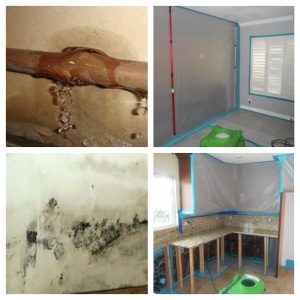There’s mold everywhere!!!
No really, there is mold everywhere. Think of mold as a microscopic dandelion. It needs a food source, water and time and soon enough it releases its seeds or spores into the air in order to reproduce at other locations. These seeds or spores then stick to surfaces and when they detect water and begin to grow thus repeating the cycle. This is nature’s way of getting rid of dead cellular organisms like plants and trees.
Every environment on earth has a natural level of mold spores in the air. You are breathing them into your respiratory tract as you read this blog. So what is all the hype about? Wouldn’t it already be there? The answer is yes it is already there. It sits there waiting for water, food and time to grow. Once all those ingredients exist voila! Mold begins grow. Individual spores mature form colonies, which then become visible to the human eye. Up until then mold is invisible to the human eye. Most mold spores are from 3-20 microns. To put this into perspective the diameter of one hair on your head is about 50 microns. Even gravity doesn’t have the same affect on spores. Spores can hang in the air for hours before settling on a horizontal surface. Only to be whisked back up into the air from the breeze of a passerby.
So when does mold become a problem? Mold becomes a problem when you have water intrusion into your home or business with or without your knowledge. Even excessive humidity can be enough for mold to start to colonize. Wet organic materials such as drywall, particle board, OSB plywood, wood framing, tack strip, cabinetry, wool, leather, cotton and other cellulosic materials are the perfect food for mold. Then sprinkle a little time into the equation and there it is. Green, Black, blue, pink, purple, yellow and brown are just a few of the color’s that mold can decorate your walls with. Health concerns may arise when excessive mold grows indoors. Concerns are more likely to arise for “at risk” people, which might include immune suppressed or compromised individuals, young children and individuals with chronic inflammatory lung diseases such as asthma and severe allergies. However, anyone may experience health problems associated with exposure to mold in damp buildings. Possible health effects include: runny nose, sneezing, coughing, aggravation of asthma, sore throat or inflammation of the sinuses.
How to return mold levels back to normal. Returning the environment back to original mold levels requires the help of a mold remediation contractor and an IEP (Indoor environmental professional). Mold remediation contractors remove the mold and IEP’s test to make sure the mold remediation contractor has performed his job properly. They also create a clearance report for the building (often times referred to as a mold certificate).
Basic Steps of Mold Remediation
- Identify the source of the water and fix the problem.
- Containment of the work area.
- Negative air pressure and HEPA filtration.
- Removal and cleaning of salvageable items.
- Removal of affected materials. (ie. Drywall, Baseboard, cabinetry boxes etc.)
- Removal of double bagged & gooseneck sealed debris.
- Sanding and cleaning of salvageable materials. (Wood framing, concrete and other non porous materials).
- Cleaning of the affected and non affected areas inside of containment.
- HEPA vacuuming of all surfaces inside of containment.
- 24 hours of air scrubbing.
- Post remediation clearance testing to verify normal fungal ecology is present.
Warning: This work should not be performed by anyone who does not have the proper, certification, personal protective equipment (PPE), experience and in this field.


Servpro did an amazing job when I had a fire in my home. The cleaning crews were amazing. My house came out looking even better than it did before. They truly live up to their slogan “like it never even happened”.
LikeLike